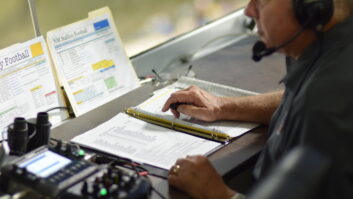Last time we compared Internet radio and HD Radio as future digital platforms for broadcasters, concluding with the caveat that Internet radio’s biggest downside — its immobility — might be short-lived. The promise of a broadband wireless Internet future has been hyped for several years, yet in the United States, it remains elusive, just beyond the grasp.
The next year or two will likely put an end to this, as mobile broadband deployments begin in earnest in the U.S. mobility market.
Cordless vs. cellular
It’s therefore time to consider what broadband mobile wireless will really be like. There are two basic models, both of which exist in some form today. One is WiFi, which is about as close to a wireless form of wired network as you can get. In its various flavors, WiFi is truly just a last-millimeter extension of an Ethernet network, allowing the same functionality as its wired brethren, but without the wire, over a short distance.
Thus one model of broadband wireless Internet service would simply expand upon WiFi to enable higher bandwidths, longer connection distances and seamless handoff between access points for mobile users.
The other model evolves from cellular data service, which is very different. WiFi is a technology, while wireless telco data is a business. WiFi is inherently unlicensed and intended for private uses, while mobile data is licensed and operated as a for-profit commercial industry. Yes, some companies have set up commercial WiFi hotspots, but generally, these are again equivalent to a pay-as-you-go ISP. Meanwhile some cities have set up free or subsidized municipal WiFi networks.
A semi-apt analogy for this distinction from the consumer’s perspective considers WiFi as the cordless phone, while wireless data is the cellular phone.
Differences abound
While WiFi strictly follows the IEEE family of 802.11 standards, the wireless data environment includes numerous delivery formats such as WAP, GPRS, EDGE, UMTS and EV-DO, each chosen by the wireless telco providing service. There is also no standard browser, screen size or aspect ratio, no standard keyboard or mouse, and limited ability for consumers to change or upgrade their terminals. More important, changing service providers often means a forced changing of terminals in the bargain. (Would the Internet have been as successful in its early days if it had been saddled with these attributes?)
But perhaps the biggest difference between these approaches is that the content delivered on wireless data services is telco-controlled, and in a way that is often far more constraining than anything done by the ISPs to which WiFi service typically connects.
From a regulatory perspective, one could say that there is no network neutrality on the wireless telco data environment, while the WiFi world is generally indistinguishable from the wired Internet in this respect.
So which business model will the mobile, broadband wireless Internet follow? The net-neutral ISP approach or the wireless data walled garden?
Whither WiMax?
The most likely form of mobile broadband wireless Internet connectivity to follow the WiFi model is called WiMAX, while the wireless telco offerings are lumped under the generic heading of “3G.” But even WiMAX may take multiple forms, in that it may be offered in both licensed and unlicensed forms. In the licensed case, who will be the licensees? (Probably telcos.)
The network neutrality issue therefore is critical to radio stations that look to the wireless Internet — either via WiMAX or 3G — as a future service platform. First, one bit of good news is that an audio service doesn’t suffer from the variations in screens and input devices noted above — audio is audio (and generally in stereo) throughout the environment, more or less. But Internet radio services may want to offer some visual metadata to accompany their audio signals, so verifying how this data displays on a wide range of platforms and devices will be required.
Also consider that if the telco-controlled model prevails, extensions to include higher audio quality or surround sound might be difficult to achieve. New codecs or other downloadable plug-ins may be unavailable, and content rights-management may make user experiences painful, if not transparently applied.
More important, if legislation or regulation does not explicitly prohibit it, certain signals might be blocked, or their bandwidth constrained, in any given region. This could allow a radio station’s streaming audio signal to be rendered unreceivable in a certain area, based solely on a unilateral decision of the wireless service provider. Of course, this decision might be made because another customer of the wireless telco requested (or paid for) it.
Consider the two-edged sword that might be wielded by radio stations in such a case: A station could arrange for its local wireless telco(s) to block certain out-of-market competitors from delivering their similarly formatted station’s signals into the home market — but, of course, stations in other markets could do the same thing. It seems a slippery — and expensive — slope to traverse, and one that may be made moot in the interim by new telecom legislation anyway. Wouldn’t it be better to just allow competition on a level — albeit much larger — field?
This is one reason for broadcasters to be interested in the ongoing net-neutrality debate in Congress. It’s also a time for close observation of how the U.S. wireless broadband Internet environment will be shaped by the FCC and other market forces. Where these current variables settle will have great influence on the impact of wireless Internet service on the radio industry — for better or for worse.












